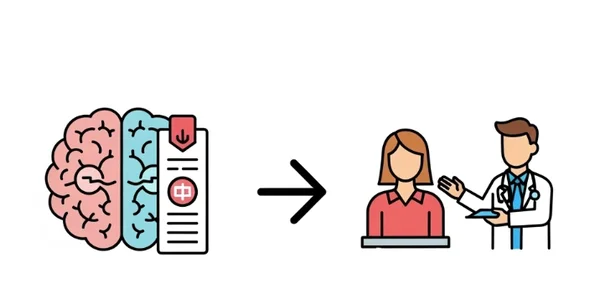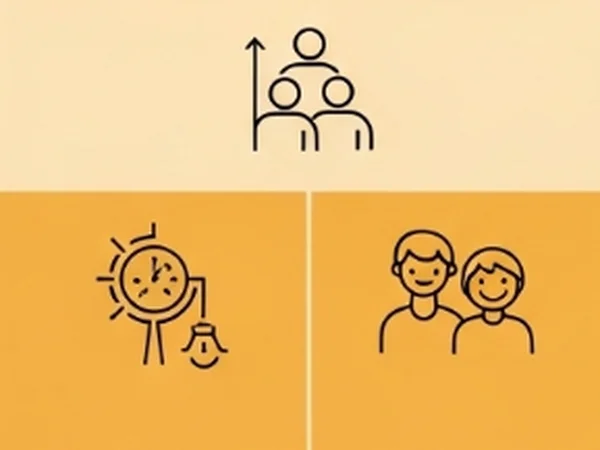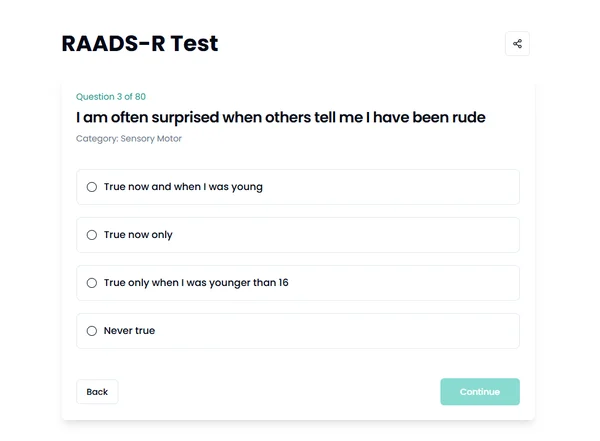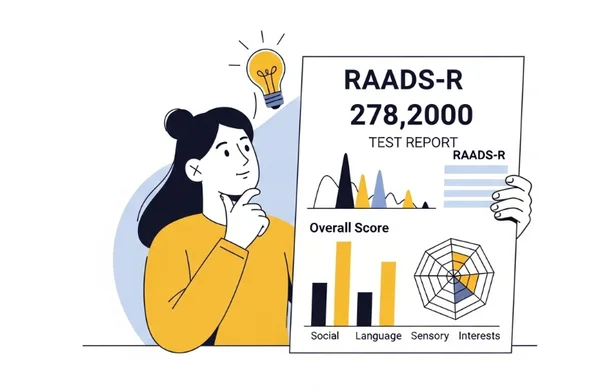RAADS-R Test: A Guide to Adult Autism Self-Assessment
Embarking on a journey of adult autism self-assessment can be both enlightening and a little daunting. Many adults find themselves wondering about their unique traits and experiences, seeking tools that can offer initial insights. The RAADS-R test (Ritvo Autism Asperger Diagnostic Scale-Revised) is one such valuable resource. What is the RAADS-R test and how can it help? This comprehensive RAADS-R guide is designed to walk you through everything you need to know about using this online autism test for self-exploration, from understanding its purpose and structure to taking the test and preliminarily interpreting your results. At raads-r.net, we aim to make this process as clear and accessible as possible.
What is the RAADS-R Test? Understanding This Adult Autism Screener
Before you begin, it's important to understand what the RAADS-R test is and what it isn't. This knowledge will help you approach the self-assessment with realistic expectations.
Purpose of the RAADS-R: A Tool for Self-Reflection and Initial Screening
The primary purpose of the RAADS-R is to serve as a screening tool for adults (typically aged 18 and older) who suspect they might have traits consistent with Autism Spectrum Disorder (ASD). It's designed to facilitate self-reflection by presenting a structured series of questions about lifelong experiences and behaviors. It helps individuals quantify certain characteristics often associated with autism, providing a starting point for further understanding or professional consultation. Many users ask, "how does the raads-r test work for adult autism self-assessment?" – it works by systematically exploring key areas.
Who is the RAADS-R Test For? Target Audience Explained
The target audience for the RAADS-R test includes:
- Adults who are curious about whether their personal experiences align with autistic traits.
- Individuals who have long felt "different" but have never received a formal assessment.
- Those seeking a structured way to understand their social, communicative, sensory, and interest-based patterns before potentially seeking professional advice.
- Family members or partners looking to better understand an adult loved one. It's designed for individuals with at least average intelligence who can reliably self-report on their past and present experiences.
RAADS-R as a Screening Tool vs. a Diagnostic Instrument: A Crucial Distinction
It is absolutely crucial to understand that the RAADS-R is a screening tool, not a diagnostic instrument. While a high score may indicate the presence of autistic traits and suggest that a professional evaluation is warranted, the RAADS-R itself cannot provide a formal diagnosis of ASD. A diagnosis can only be made by a qualified healthcare professional through a comprehensive assessment process. This distinction is vital for managing expectations about what the RAADS-R test can and cannot do.

Key Domains Assessed by the RAADS-R Test Questions: Understanding the Structure
The RAADS-R test questions are thoughtfully designed to cover a range of experiences relevant to the autism spectrum. The 80 items are typically grouped into four key RAADS-R domains. What are the sections of the raads-r test?
Social Relatedness: Navigating Social Interactions and Relationships
This domain explores aspects of social relatedness, including difficulties with:
- Initiating and maintaining friendships and romantic relationships.
- Understanding and responding to social cues (e.g., body language, tone of voice).
- Reciprocal (back-and-forth) conversation and social engagement.
- Feeling like an outsider or different from others in social situations. The test questions in this area aim to capture lifelong patterns in social interactions.
Language: Understanding Communication Nuances and Pragmatics
The language domain focuses on both expressive and receptive communication, including:
- Literal interpretation of language (e.g., difficulty understanding sarcasm, idioms, or implied meanings).
- Unusual use of language, such as formal speech, pedantic phrasing, or echolalia (repeating words or phrases).
- Difficulties with the pragmatic (social) use of language – knowing what to say, how to say it, and when to say it in different social contexts. Understanding RAADS-R involves recognizing how these communication nuances are explored.
Sensory-Motor: Experiences with Senses and Movement Patterns
This section assesses sensory-motor experiences, such as:
- Atypical sensory sensitivities: Being over- or under-sensitive to sounds, lights, textures, smells, tastes, or pain.
- Sensory-seeking behaviors or sensory overload experiences.
- Repetitive motor mannerisms (stimming), such as hand-flapping, rocking, or fidgeting.
- Difficulties with motor coordination or clumsiness. These senses and movement patterns are common areas of difference for many on the spectrum.
Circumscribed Interests: Exploring Focused Passions and Need for Routine
The domain of circumscribed interests (often referred to as special interests) explores:
-
Intense, highly focused, and sometimes unusual interests in specific topics or objects.
-
A strong preference for routines, sameness, and predictability.
-
Difficulty with unexpected changes or transitions.
-
A tendency towards systematic thinking or collecting. These focused passions and routines are a core characteristic often assessed.

How to Take the RAADS-R Test Online: A Step-by-Step Guide
Taking the RAADS-R test online is a straightforward process. This how to take RAADS-R guide will help you navigate it.
Accessing the Free RAADS-R Test on raads-r.net
Our platform offers a free RAADS-R test. Simply visit our website and look for the "Start Test" or similar button. The test is accessible without requiring registration, ensuring your privacy.
Tips for Answering the RAADS-R Questionnaire Honestly and Accurately
For the most meaningful results from this self-report questionnaire:
- Be Honest: Answer based on your genuine lifelong experiences, not how you think you "should" be or how others perceive you.
- Consider "Now and When Young": Many questions ask you to reflect on your experiences both currently and when you were younger than 16. Try to recall patterns from your childhood and adolescence.
- Don't Overthink: Go with your first instinct if you're unsure. There are no "right" or "wrong" answers.
- Take Your Time: While there's no time limit, try to complete it in one sitting in a quiet environment where you can focus. Answering honestly and accurately is key.
Understanding the Response Options (e.g., "True now and when young")
The RAADS-R typically uses a set of response options for each statement. Common options include:
- True now AND when I was young (before age 16)
- True now only
- True only when I was younger (before age 16)
- Never true Understanding these options is crucial for accurately reflecting your experiences across different life stages.
What to Expect After Submitting Your Answers: Receiving Your Score
After completing all 80 questions and submitting your answers, you will typically receive your overall RAADS-R score immediately on the screen. Our website also offers an optional AI Personalized Analysis for deeper insights after you receive your initial scoring.

Preliminary Understanding of Your RAADS-R Test Results
Once you have your score, the next step is understanding RAADS-R results at a preliminary level. What do RAADS-R results mean?
What the Overall RAADS-R Score Indicates
The overall RAADS-R score provides a quantitative indication of the extent to which your self-reported experiences align with traits commonly associated with autism in adults. A higher score generally suggests a greater number or intensity of these traits.
A Note on Score Ranges and Research Thresholds (Not Diagnostic Cutoffs)
Research often cites a score range or threshold (commonly around 65) above which an individual's responses are considered indicative of autistic traits. However, it's vital to remember these are research-based thresholds and not diagnostic cutoffs. Many factors can influence a score, and a score above this threshold does not automatically mean you are autistic, nor does a score below it definitively rule it out. The interpretation requires nuance.
Considering Your Scores in Each of the Four Domains (If Provided)
Some versions or analyses of the RAADS-R may provide sub-scores for each of the four domains (Social Relatedness, Language, Sensory-Motor, Circumscribed Interests). Looking at these can offer more specific insights into which areas you endorsed more traits. Our AI analysis feature, for example, considers these domain-specific patterns.

Beyond the Score: What to Do After Your Adult Autism Self-Assessment
Completing an adult autism self-assessment like the RAADS-R is often just the beginning of a journey. So, what are the next steps?
Self-Reflection: Connecting Results to Your Lived Experiences
The most important step is self-reflection. How do the results align with your lived experiences? Do they provide a new lens through which to understand past challenges or current ways of being? Does the pattern of your answers in different RAADS-R domains make sense to you?
Exploring Further Resources: Our AI Analysis & Educational Blogs
At raads-r.net, we offer more than just the test. Consider exploring our AI Personalized Analysis feature for a deeper, more contextualized interpretation of your RAADS-R results. Additionally, our educational blogs (like this one!) provide further information on autism, self-assessment, and related topics.
When to Consider Professional Consultation for a Full Evaluation
If your RAADS-R score is high, if the results resonate strongly with your experiences and cause you distress or impairment, or if you simply desire diagnostic clarity, it is advisable to consider a professional consultation. A full evaluation by a clinician experienced in adult autism can provide a definitive diagnosis and guidance. The RAADS-R test results can be a helpful starting point for this conversation.

Your RAADS-R Journey: A Starting Point for Self-Discovery
The RAADS-R test is a powerful online autism test that serves as an excellent starting point for self-discovery in the realm of adult autism self-assessment. This RAADS-R guide aims to equip you with the knowledge to use the tool effectively and understand its results preliminarily. Remember, it's a tool for insight and reflection, not a final label. Your journey of understanding RAADS-R and yourself is unique and valuable.
What are your experiences with self-assessment tools like the RAADS-R? Do you have more questions about the process? We encourage you to share your thoughts and engage in the comments below!
Understanding and Using the RAADS-R Test
-
What exactly is the RAADS-R test measuring?
The RAADS-R test measures the presence and intensity of self-reported traits and behaviors across four key domains often associated with Autism Spectrum Disorder in adults: Social Relatedness, Language, Sensory-Motor experiences, and Circumscribed Interests. It assesses lifelong patterns.
-
How long does it take to complete the online RAADS-R test?
Most individuals complete the 80-question online RAADS-R test in approximately 20-30 minutes, though there is no strict time limit. It's best to take your time and answer thoughtfully.
-
Is the RAADS-R test on raads-r.net free to use?
Yes, the RAADS-R test provided on our site is a free autism test available for anyone wishing to conduct an initial adult autism self-assessment.
-
What should I do if my RAADS-R score is high?
A high RAADS-R score suggests a significant number of autistic traits. It's recommended to engage in self-reflection, perhaps explore our AI Personalized Analysis for more context, and importantly, consider discussing your results and experiences with a qualified healthcare professional for a comprehensive autism evaluation.
-
How can understanding the RAADS-R domains help me?
Understanding RAADS-R domains (Social Relatedness, Language, Sensory-Motor, Circumscribed Interests) can provide more specific insights into which areas of your experience contribute most to your overall score. This can help you identify particular strengths or challenges and guide your self-reflection or discussions with a professional. You can learn more and take the test on our website.